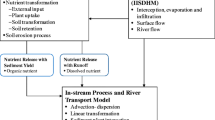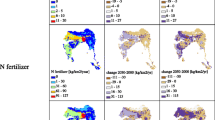Abstract
In many European rivers, including the major streams of the Rhine and Elbe basins, the nutrient load (N and P) still exceeds target levels. In this paper, a model is presented that describes the river nutrient load as a function of nutrient sources, runoff and lithology in the upstream basin. The model was tested with independent data on nutrient sources (input) and nutrient river load (output) for 130 specific combinations of sub-basins and 5 year periods. A wide range of river systems within the Rhine and Elbe basins were included and the analysis covers a period of 25 years from 1970 to 1995. Most of the observed spatial and temporal variation in the average annual river nutrient load was successfully described by the model. It is therefore concluded that the model can be used to predict the effect of changes in nutrient sources (e.g. reduction of livestock numbers, further improvement of waste water treatment plants etc.) on the average annual nutrient loads of the rivers Rhine, Elbe and their main tributaries.
Similar content being viewed by others
References
Behrendt, H., 1993. Point and diffuse loads of selected pollutants in the river Rhine and its main tributaries. Research report-93-1. IIASA, Laxenburg, Austria: 84 pp.
Behrendt, H., 1996. Inventories of point and diffuse sources and estimated nutrient loads - a comparison for different river basins in central Europe. Wat. Sci. Tech. 33: 99-107.
Brouwer, F. M., F. E. Godeschalk, P. J. G. J. Hellegers & H. J. Kelholt, 1995. Mineral balances at farm level in the European Union. Agricultural Economics Research Institute (LEI-DLO). The Hague, The Netherlands. Report no. 137: 141 pp.
DeWit, M. J. M., 1999. Nutrient fluxes in the Rhine and Elbe basins. PhD Thesis. Utrecht University, The Netherlands.
De Wit, M. J. M. & H. Behrendt, 1999. Nitrogen and Phosphorus emissions from soil to surface water in the Rhine and Elbe basins. Wat. Sci. Tech. 39 (12): 109-116.
Frede, H. G. & M. Bach, 1995. Regional differenzierte Abschätzung des Nitrateintrags aus diffusen Quellen in das Grundwasser. Untersuchung für die Bundesrepublik Deutschlands im neuen Gebietsstand. Institut fur Landeskultur. Gießen, Germany: 126 pp.
Garnier, J., G. Billen & E. Hannon, 1995. Biogeochemical Nutrient Cycling in Large River Systems (Binoculairs). 1ste progress report: 29 pp.
Grimvall, A. & P. Stålnacke, 1996. Statistical methods for source apportionment of riverine loads of pollutants. Journal of Environmetrics 7: 201-213
Hamm A., D. Gleisberg, W. Hegemann, K. H. Krauth, G. Metzner, F. Sarfert & P. Schleypen, 1991. Stickstoff-und Phosporeintrag in Oberflächengewässer über 'punktförmigen Quellen'. In A. Hamm (ed.), Studie über Wirkungen und Qualitätsziele von Nährstoffen in Fließgewässern. Academia Verlag, Sankt Augustin: 765-798.
IAH. International Hydrogeological Map of Europe (various sheets). UNESCO, Paris.
IKSE, 1995. Bestandsaufnahme von bedeutenden punktuellen kommunalen und industriellen Einleitungen von prioritären Stoffen im Einzugsgebiet der Elbe. International Commission for the Protection of the Elbe. Magdeburg.
IKSR, 1992. Aktionsprogramm Rhein. Bestandsaufnahme der Einleitungen prioritärer Stoffe 1992. International Commission for the Protection of the Rhine. Koblenz.
Klepper, O., A. H. W. Beusen & C. R. Meinardi, 1995. Modelling the flow of Nitrogen and Phosphorus in Europe: From loads to coastal seas. RIVM report no. 461501004. Bilthoven: 32 pp.
Oslo and Paris Commission, 1993. Nutrients in the convention area 1993. The Chameleon Press Limited. London.
Owens, N. J. P., 1993. Nitrate cycling in marine waters. In T. P. Burt, A. L. Heathwaite & A. L. Trudgill (eds), Nitrate. Wiley. Chichester: 169-209.
Stanners, D. & P. Bourdeau, 1995. Europe's Environment. The Dobris Assessment. European Environment Agency (EEA). Copenhagen, Denmark.
Van Dijk, G.M., E. C. Marteijn & A. Schulte-Wülwer-Leidig, 1995. Ecological rehabilitation of the river Rhine: plans, progress and perspectives. Regul. Riv. 11: 377-388.
Wendland, F., 1992. Die Nitratbelastung in den Grundwasserlandschaften der 'alten' Bundesländer (BRD). Berichte aus der Okologischen Forschung, Band 8. KFA. Jülich: 150 pp.
Werner, W. & H. P. Wodsak, 1994. Stickstoff-und Phosphateintrag in die Fließgewässer Deutschlands unter besonderer Berücksichtigung des Eintragsgeschehens im Lockergesteinbereich der ehemaligen DDR. Agrarspektrum, 22. Frankfurt am Main: 243 pp.
Author information
Authors and Affiliations
Rights and permissions
About this article
Cite this article
de Wit, M. Modelling nutrient fluxes from source to river load: a macroscopic analysis applied to the Rhine and Elbe basins. Hydrobiologia 410, 123–130 (1999). https://doi.org/10.1023/A:1003783109031
Issue Date:
DOI: https://doi.org/10.1023/A:1003783109031




